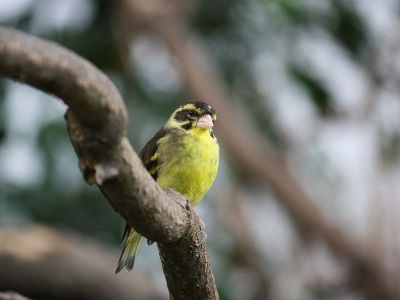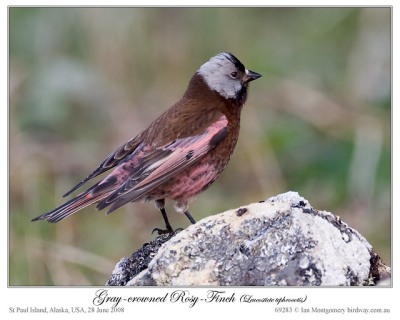
American Red Crossbill for Birds Illustrated by Color Photography, 1897
From Col. F. M. Woodruff
Birds Illustrated by Color Photography – Revisited
Vol 1. April, 1897 No. 4
*
THE AMERICAN CROSS BILL.

MERICAN CROSSBILLS are notable for their small size, being considered and described as dwarfs of the family. Their food consists exclusively of pine, fir, and larch, which accounts for the fact that they are more numerous in Northern latitudes where these trees abound. When the cones are abundant they visit in great numbers many places where they have not been for years, appearing at irregular intervals, and not confining themselves to particular localities. They are very social even during the nesting season. Their nests are built among the branches of the fir trees, and there they disport themselves gaily, climbing nimbly, and assisting their movements, as parrots do, with their beaks. They will hang downward for minutes clinging to a twig or cone, seeming to enjoy this apparently uncomfortable position. They fly rapidly, but never to a great distance. “The pleasure they experience in the society of their mates is often displayed by fluttering over the tops of the trees as they sing, after which they hover for a time, and then sink slowly to their perch. In the day time they are generally in motion, with the exception of a short time at noon. During the spring, summer and autumn they pass their time in flying from one plantation to another.”
The Crossbill troubles itself but little about the other inhabitants of the woods, and is said to be almost fearless of man. Should the male lose his mate, he will remain sorrowfully perched upon the branch from which his little companion has fallen; again and again visit the spot in the hope of finding her; indeed it is only after repeated proofs that she will never return that he begins to show any symptoms of shyness. In feeding the Crossbill perches upon a cone with its head downwards, or lays the cone upon a branch and stands upon it, holding it fast with his sharp, strong pointed claws. Sometimes it will bite off a cone and carry it to a neighboring bough, or to another tree where it can be opened, for a suitable spot is not to be found on every branch. The nest is formed of pine twigs, lined with feathers, soft grass, and the needle-like leaves of the fir tree. Three or four eggs of a grayish or bluish white color, streaked with faint blood red, reddish brown, or bluish brown spots, are generally laid. The following poem is quite a favorite among bird lovers, and is one of those quaint legends that will never die.
THE LEGEND OF THE CROSSBILL.
(From the German of Julius Mosen, by Longfellow)
On the cross the dying Saviour
Heavenward lifts his eyelids calm,
Feels, but scarcely feels, a trembling
In his pierced and bleeding palm.
And by all the world forsaken,
Sees he how with zealous care
At the ruthless nail of iron
A little bird is striving there.
Stained with blood and never tiring,
With its beak it doth not cease,
From the cross it would free the Saviour,
Its Creator’s son release.
And the Saviour speaks in mildness:
“Blest be thou of all the good!
Bear, as token of this moment,
Marks of blood and holy rood!”
And that bird is called the Crossbill,
Covered all with blood so clear,
In the groves of pine it singeth,
Songs, like legends, strange to hear.
But what saith it? The word is nigh thee, even in thy mouth, and in thy heart: that is, the word of faith, which we preach; That if thou shalt confess with thy mouth the Lord Jesus, and shalt believe in thine heart that God hath raised him from the dead, thou shalt be saved. For with the heart man believeth unto righteousness; and with the mouth confession is made unto salvation. (Romans 10:8-10 KJV)

Red Crossbill (Loxia curvirostra) ©WikiC
Lee’s Addition:
Also, to every beast of the earth, to every bird of the air, and to everything that creeps on the earth, in which there is life, I have given every green herb for food”; and it was so. (Genesis 1:30 NKJV)
The Lord has created another neat bird and provided it with a unique way to feed. This bird belongs to the Finch – Fringillidae Family and are characterised by the mandibles crossing at their tips, which gives the group its English name. Adult males tend to be red or orange in colour, and females green or yellow, but there is much variation. They have a length of 5.5-7.9 in (14-20 cm) and a wingspan of 9.8-10.6 in (25-27 cm) and they weigh .8-1.6 oz (24-45 g).
These are specialist feeders on conifer cones, and the unusual bill shape is an adaptation to assist the extraction of the seeds from the cone. These birds are typically found in higher northern hemisphere latitudes, where their food sources grows. They will erupt out of the breeding range when the cone crop fails. Crossbills breed very early in the year, often in winter months, to take advantage of maximum cone supplies.

Red Crossbill (Loxia curvirostra) Female ©WikiC
Rather than a defect, as some claim, “the crossed bill is a wonderful adaption to the habits of these birds. This design makes it possible for the seeds of fir cones from coniferous trees to be picked out with very little difficulty. These seeds represent the Crossbill’s main food although apple pips are also a favoured treat. These birds will also feed happily on insects and other fruit seeds in the winter, at which time they will travel in any direction on the compass to visit deciduous forests, gardens, flat plains and groves in search of food.” (Wonder of Birds)
“A crossbill’s odd bill shape helps it get into tightly closed cones. A bird’s biting muscles are stronger than the muscles used to open the bill, so the Red Crossbill places the tips of its slightly open bill under a cone scale and bites down. The crossed tips of the bill push the scale up, exposing the seed inside.” (All About Birds)

Birds Illustrated by Color Photograhy Vol 1 April 1897 No 4 – Cover
Birds Illustrated by Color Photography – Revisited – Introduction
The above article is the first article in the monthly serial for February 1897 “designed to promote Knowledge of Bird-Live.” These include Color Photography, as they call them, today they are drawings. There are at least three Volumes that have been digitized by Project Gutenberg.
To see the whole series of – Birds Illustrated by Color Photography – Revisited
*
(Information from Wikipedia and other internet sources)
Next Article – Bird Day In The Schools
Previous Article – Smith’s Painted Longspur
Wordless Birds
Links:
Crossbill – The Bird and its Unusual Bill by Wonder of Birds
Legend of the Crossbills
Fringillidae – Finches
Red Crossbill – All About Birds
Crossbill~ Common Crossbill ~ Two-barred Crossbill by Wikipedia
*


































